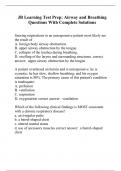-
1. Exam (elaborations) - Ch 31 quiz jbl questions with complete solutions
-
2. Exam (elaborations) - Jbl emt: chapter 3 questions with complete solutions
-
3. Exam (elaborations) - Trauma jblearning test prep questions with complete solutions
-
4. Exam (elaborations) - Paramedic jb learning| 1461 questions| with complete solutions
-
5. Exam (elaborations) - Ems systems jb learning exam 1 (ch 1) questions with complete solutions
-
6. Exam (elaborations) - Emr- jb learning test questions chapters 1-11 questions with complete solutions
-
7. Exam (elaborations) - Emt unit 2 exam jb learning questions with complete solutions
-
8. Exam (elaborations) - Chapter 11 emt jb learning questions with complete solutions
-
9. Exam (elaborations) - Emt ch 1-4 (jb learning) questions with complete solutions
-
10. Exam (elaborations) - Jb learning – operations questions with complete solutions
-
11. Exam (elaborations) - Jb learning test prep: airway and breathing questions with complete solutions
-
12. Exam (elaborations) - Emt jblearning book study words questions with complete solutions
-
13. Exam (elaborations) - Jblearning emt block test 2 questions with complete solutions
-
14. Exam (elaborations) - Jblearning emt chapter 6 questions with complete solutions
-
15. Exam (elaborations) - Jb learning nremt questions with complete solutions
-
16. Exam (elaborations) - Emt chapter 22 jb learning questions with complete solutions
-
17. Exam (elaborations) - Emt final-jb learning| 221 questions| with complete solutions
-
18. Exam (elaborations) - Jb learning test prep cardiology/trauma questions with complete solutions
-
19. Exam (elaborations) - Emt jbl operations practice test questions with complete solutions
-
20. Exam (elaborations) - Emt final exam jblearning questions with complete solutions
-
21. Exam (elaborations) - Emt final-jb learning questions with complete solutions
-
22. Exam (elaborations) - Emt final exam jbl questions with complete solutions
-
23. Exam (elaborations) - Jb learning final exam| 242 questions | with complete solutions
-
24. Exam (elaborations) - 210 final study guide emt jbl questions with complete solutions
-
25. Exam (elaborations) - Jbl module 1 exam questions with complete solutions
-
26. Exam (elaborations) - Jb learning: emt final exam| 200 questions| with complete solutions
-
27. Exam (elaborations) - Emt jblearning phb final study questions with complete solutions
-
28. Exam (elaborations) - Jbl registry practice test questions with complete solutions
-
29. Exam (elaborations) - Emt jbl ob/gyn practice test questions with complete solutions
-
30. Exam (elaborations) - Emt exam 4 jb learning questions with complete solutions
-
31. Exam (elaborations) - Jb learning exam 7 review questions with complete solutions
-
32. Exam (elaborations) - Jb learning test prep questions with complete solutions
-
33. Exam (elaborations) - Jbl module 3 practice exam questions with complete solutions
-
34. Exam (elaborations) - Jb learning test prep: cardiology questions with complete solutions
-
35. Exam (elaborations) - Jb learning exam 6 review questions with complete solutions
-
36. Exam (elaborations) - Emt 38-41 (jbl) questions with complete solutions
-
37. Exam (elaborations) - Emt-jbl mid term questions (covers questions for past module exams) with complete sol...
-
38. Exam (elaborations) - Emt chapters 1-8: online quizzes set (jbl: 80 questions) with complete solutions
-
39. Exam (elaborations) - Jbl operations questions with complete solutions
-
40. Exam (elaborations) - Jbl module 2 practice exam questions with complete solutions
-
41. Exam (elaborations) - Emt jbl quizzes questions with complete solutions
-
42. Exam (elaborations) - My emt-b final prep all them jbl quizzes questions with complete solutions
-
43. Exam (elaborations) - Emt jbl review questions with complete solutions
-
44. Exam (elaborations) - Emt-test #4 (eoc, jbl, green star) questions with complete solutions
-
45. Exam (elaborations) - Emt jbl review (mod 4a) questions with complete solutions
-
46. Exam (elaborations) - Emt exam 6 chap 33-41 (jbl) questions with complete solutions
-
47. Exam (elaborations) - Emt chapter 6 jbl vocab/quiz questions with complete solutions
-
48. Exam (elaborations) - Emt exam 2 chap 9-13 (jbl) questions with complete solutions
-
49. Exam (elaborations) - Chapters 1-10 emt jbl hw final questions with complete solutions
-
50. Exam (elaborations) - Emt exam 3 chap 14-18 (jbl) questions with complete solutions
-
51. Exam (elaborations) - Chapters 14, 15, 16 emt-b jbl questions with complete solutions
-
Show more




